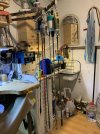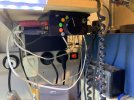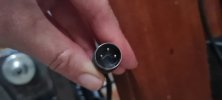You are using an out of date browser. It may not display this or other websites correctly.
You should upgrade or use an alternative browser.
You should upgrade or use an alternative browser.
still kicking
- Thread starter Dani Girl
- Start date
Sinterklaas
Elite Cafe Member
For brittle stuff it works also. At low speeds. But then I would use diamond burrs. They have no teeth so they won't really start to run off on you.I stand corrected.
I guess I at least got the bit about the unruliness of a flexshaft right..
I am curious, if the slower RPM and higher torque is more manageable for cutting stone seats, how does a micro-motor perform when cutting other more brittle mediums? such as glass, eggshell, mother of pearl, or abalone?
This may be a unusual question, but have you ever used it to try and remove a broken screw or tap from a hole? I'm curious of other advantages of the torque over RPM and if, with appropriate technique, there is any true benefit to higher RPM..
I have also used either carbid or diamond burrs to remove broken burrs and taps. It work well. Just go slow so the tool will stay cool. And will keep its cutting properties much longer.
Dentist use high rpm tools. But they are always watercooled. The dental machines all have a water jet shooting at the burr to keep it cool and maybe to prevent dust that is breathable.
_________________________
Dani, Another problem might be how you hold the tool.
If you hold the motor to far back it will run off.
I hold the micromotor at its very tip. Just like a pen. And I even have 1 finger against the shaft of the burr. And an other finger on the metal. So I have good control close to the cutting action.
For stone setting I use only flexible shaft tools at low speed. Position of the stone marked with a deep dot from a scriber, I drill first a 0.5 mm hole through the metal with a spiral drill. For the rest of the work I use round dentaI reverse the direction of rotation. Build a special controller for this, with a selector switch for my 5 flex shafts. The burr will still remove material if rotated in the wrong direction, but much slower and without chatter. I set down the burr on the metal and start rotation slowly with the foot pedal. Thanks to Ganoksin for the “reverse rotation” idea…
...
I mounted 5 flex shafts (4 of them light and small like the Dremel flex shaft) onto DC motors with different max. speeds, which I control all with one foot pedal with selector switch.
Reverse direction.. .. at first I missed the part about having mounted the flex shafts to dc motors and was dumbfounded how this could be done but upon checking the 2 foredoms I have access to I found that one is indeed AC 120 but low and behold the other is a 120v DC motor .. I believe this could be adapted for reverse with a simple pigtail with an inverted plug at the footcontroll... And after reading the post in this thread, perhaps I will be starting down another rabbit hole of tools..
This .470 inch (12mm) flex shaft still seems less than optimal for handling with fine inlays, perhaps I just need to 'relocate' it to the engraving bench to try some finer work with it.. the picture you provided appears to have different sizes of flex shafts, is that just an optical illusion or are there indeed various sizes (diameter) available?
rweigel
Elite Cafe Member
Hello Meshach, I use different styles of flex shafts. One standard size came with the big green-gray motor, the other standard size shaft (the red one) I bought as a spare and connected it to a really slow DC motor. Both accept exchangable handpieces of european style. The red flex shaft is especially usefull for the setting hammer handpiece.
The smaller flex shafts got non-exchangable handpieces that accept collets from 0.5 to 3.5 mm, and with an adapter piece also small jacobs chucks with the same diameter range. They come from the european company “Proxxon” and are comparable in size to the ”Dremel” flex shaft. Many goldsmiths dismiss them as “toy”, but I have good experience with them. Bought most of them at ebay, cost me 10-20 Euro per piece, 2 of my purchases did not work or had exessive tolerances. Overall, a good deal. Setting is not hard work for the flex shaft, they do not wear out from it. They are about 50% of a standard flex shaft in shaft and handpiece diameter.
The smaller flex shafts got non-exchangable handpieces that accept collets from 0.5 to 3.5 mm, and with an adapter piece also small jacobs chucks with the same diameter range. They come from the european company “Proxxon” and are comparable in size to the ”Dremel” flex shaft. Many goldsmiths dismiss them as “toy”, but I have good experience with them. Bought most of them at ebay, cost me 10-20 Euro per piece, 2 of my purchases did not work or had exessive tolerances. Overall, a good deal. Setting is not hard work for the flex shaft, they do not wear out from it. They are about 50% of a standard flex shaft in shaft and handpiece diameter.
That sounds MUCH more manageable for detaild work! Thank you for the info I believe I will have to try out one of those tools.They are about 50% of a standard flex shaft in shaft and handpiece diameter.
.. for better or for worse I believe I am becoming a tool addict.. hehe
silver fill I engraved on the back of it, not stainlessfor this kind of work I would advise against a flex-shaft tool, they have plenty of torque and power but are harder to control and still pull a lot because they are a low speed tool.
I haven't done a ton of stone setting but what I have done was done with an ultra-high speed air rotary tool, the power carver 400xs is an example and what I have used for stone setting, unfortunately they are fairly expensive (looks like it's on sale for $400 from $550 at https://scmsysteminc.com/power-carver/ ) however if you look around there are sever other brands out nowadays and I seem to remember coming across a web post a year or so ago comparing 5 or 6 different brands some of which (if memory serves correct) were close to a quarter of the price of the 400XS, also you may look into a rotary dental tool as it may be a cheaper option but I'm not sure..
I have used (for other projects) one of these 65,000 RPM hand tools that you can get for about $20 on Amazon.. https://www.amazon.com/Air-Powered-...pcontext&ref_=fplfs&psc=1&smid=A1NE1K2SUI6UFL
and they are OK but for this type of job you will fight them.. if you learn to control it right (which for extended projects will cause a lot of strain and cramping in the hands...) then the next biggest problems is finding burs that are fine enough to do this detailed work as they use .125 inch shaft tools and most of them that I have used are rather large in the bur..
I also use a Foredom flex shaft tool pretty much daily for stock work and other heavy duty projects, they CAN be used for decent detail work but the shaft is far to stif and unrully to want to do any detailed setting work for long periods of time in my opinion.
Admittedly I don't know if there are or have experience with higher speed smaller flex shaft tools..
I believe the thing you want is RPMs in the range of 150,000 + you can stall it out fairly easily because it doesn't have a lot of torque, but at that speed it feels more like drawing with a pencil then cutting with a rotary tool and you can make those fine cuts and inlays without it grabbing and running away. it is designed to cut at high speed so rather then putting a variable foot controll on it what I have done is just put an on-off foot pedal on it's airline to make it more easily manageable. another cool thing about those ultra-high-speed tools is that you can use them to cut on glass and eggshells and many other surfaces that are nearly impossible to cut otherwise.. also you could use it to do some of your background removal that you mentioned in another of your posts..
you can find dental burs online for them at a reasonable price, you just need to look for anything with an "FG" size shaft which is .0625 inch they make them with pointed tools, cylinder shaped tools with round or flat shaped ends, round burs that can go althe way down around .020 inch (.5MM) in diamiter.
is that stainless or silver you are inlaying into? looks like a silver chain with stainless pendent. I know that rolling those prongs in stainless without breaking them is a tricky job from hearsay and from how it reacts engraving, but I haven't done any setting in it so I'm not likely to be a lot of help advising with that one..
Edit:
I also know of people who use a drill press with a stop set to get uniform sets for stones too so it's not like any one tool is the only way to go, but there are certainly tools that are better suited for any particular job..
As I said in the start, I don't have a lot of experience setting stones but that's my 2 cents and I'm sure we can get some input from some other folks too
I guess no harm in drilling some holes and seeing if I can hold onto it better. I can run the micromotor in reverse too. fast or slow? 0-45,000rpm I think it goes.
I had a little super fast air one once but the bearings died on it and replacement ones lasted minutes. tried to fix a few times. wasn't grs branded but looked like the same thing. I haven't heard any bad experiences about actual grs branded ones yet. should I save up?
in stone setting youtube videos they go really slow taking tiny nibbles with the handpiece held vertically into the drill hole and using a round bur only spinning a few rotations at a time
I had a little super fast air one once but the bearings died on it and replacement ones lasted minutes. tried to fix a few times. wasn't grs branded but looked like the same thing. I haven't heard any bad experiences about actual grs branded ones yet. should I save up?
in stone setting youtube videos they go really slow taking tiny nibbles with the handpiece held vertically into the drill hole and using a round bur only spinning a few rotations at a time
Sinterklaas
Elite Cafe Member
Just go slow. 3000 Rpm for drilling and burring. 6000 Rpm for tapered burrs when removing metal between stone seats.I guess no harm in drilling some holes and seeing if I can hold onto it better. I can run the micromotor in reverse too. fast or slow? 0-45,000rpm I think it goes.
I had a little super fast air one once but the bearings died on it and replacement ones lasted minutes. tried to fix a few times. wasn't grs branded but looked like the same thing. I haven't heard any bad experiences about actual grs branded ones yet. should I save up?
in stone setting youtube videos they go really slow taking tiny nibbles with the handpiece held vertically into the drill hole and using a round bur only spinning a few rotations at a time
I would not buy the air powered tools. They go to fast. It will wear out your tools much faster.
The Youtube video's are correct. Slow and steady wins the race.
Drill pilot hole. Then take a slightly larger ball burr and open up the hole to about 60% of the burrs height.
Then take again take the next size ball burr and again go to about 60% depth.
When you have the right size you can if need be burr a little deeper. It depends on the stones (girdle) thickness.
If you do what I described above you can "move" the hole if it is not in the correct spot. With each burr you can burr more on 1 side of the hole to move it a tiny bit.
It also matters how you hold your burr to the hole. To flat and it will run off easier. If you burr straight down then it tends to stay in the hole.
Keep your fingers close to the burr. Then you have more control.
Just practice you will get the hang of it. Just like when starting engraving you will slip.
I use a micromotor. But it needs to have enough power. I dont like flex shafts. No speed control on most and the flex shaft itself annoys me.
This is the one I have but I have the motor that is 2 parts. The nose parts I can swap. The one in the link is 1 unit. I use it for all my setting work. Micro pave, prong, channel etc. It is very powerful it has great torque.
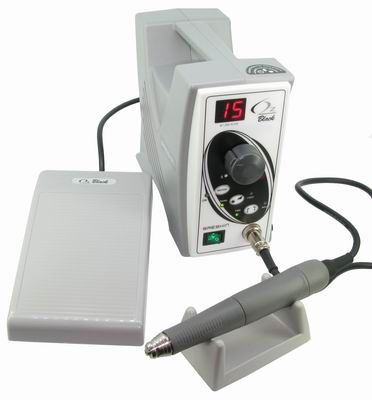
Saeshin Oz Black
The OZ Black Brushless Micro Motor is quiet, cool running, low maintenance and with an amazing 50% more torque than an average Flexible Shaft Handpiece (Faro 4.9Ncm) will deliver all the power you need. Loads of torque combined with a quick change bur release and well balanced motor provides the...
Last edited:
more torque than a flex shaft, really. I am very nervous about spending lots on a flex shaft and not liking it. I didn't like the one I tried of a friend's. I was surprised how quickly the air tool I had wore out burs if I ran it full pressure. thank you so very much for those pointers
so this may be a stupid question.. but is this the same tool? or do you think it's a fake? pricing on it is less than half the list price on the provided link..I use a micromotor. But it needs to have enough power. I dont like flex shafts. No speed control on most and the flex shaft itself annoys me.
This is the one I have but I have the motor that is 2 parts. The nose parts I can swap. The one in the link is 1 unit. I use it for all my setting work. Micro pave, prong, channel etc. It is very powerful it has great torque.

Saeshin Oz Black
The OZ Black Brushless Micro Motor is quiet, cool running, low maintenance and with an amazing 50% more torque than an average Flexible Shaft Handpiece (Faro 4.9Ncm) will deliver all the power you need. Loads of torque combined with a quick change bur release and well balanced motor provides the...www.jewellerssupplies.com.au
EDIT: main concern was due a large discrepancy in pricing but I now see that the original link is "AUSTRALIAN JEWELLERS SUPPLIES " so it only makes sense that it's listed as AUD and not USD *facepalm* looks like the pricing isn't so different after all and probably is the same tool.
Trinity Dental Equipment
Trinity Dental Equipment offers high-quality dental instruments, and cutting-edge technology for dental professionals. Discover top-rated dental x-ray, sensors, handpieces, implant motors, and more. Serving clinics and dental labs with reliable, affordable equipment for optimal patient care and...
Last edited:
I

 youtube.com
youtube.com
here is a video of what happens when I introduce a round bur slightly larger than the drill hole. I get chatter. maybe I should replace the brushes. happens with all my round burs. best I can do is gently touch it at a shallow angle but that's not good either.
I've been looking at marathon 1040 that has 50 to 50,000 rpm, torque of 8 and you can get collets and use 1/8", 3/32" or 1/16"
the Oz black is about $1,400aud
there is another for over $3000aud
https://www.jewellerssupplies.com.au/product/26220-osada-success-40-micromotor-with-handpiece.
I looked to find an nsk emax evolution that takes 360v but I'm not sure they make it??


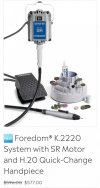



21 October 2024
here is a video of what happens when I introduce a round bur slightly larger than the drill hole. I get chatter. maybe I should replace the brushes. happens with all my round burs. best I can do is gently touch it at a shallow angle but that's not good either.
I've been looking at marathon 1040 that has 50 to 50,000 rpm, torque of 8 and you can get collets and use 1/8", 3/32" or 1/16"
the Oz black is about $1,400aud
there is another for over $3000aud
https://www.jewellerssupplies.com.au/product/26220-osada-success-40-micromotor-with-handpiece.
I looked to find an nsk emax evolution that takes 360v but I'm not sure they make it??





farmer57
Member
Dani Girl,
Another one you might want to look at is brushless micromotor, RAM Revolution 50.
I purchased mine from US based woodcarving supply house, link below but you can get it directly from Ram Products etc. I have a feeling it is very similar to Saeshin product.
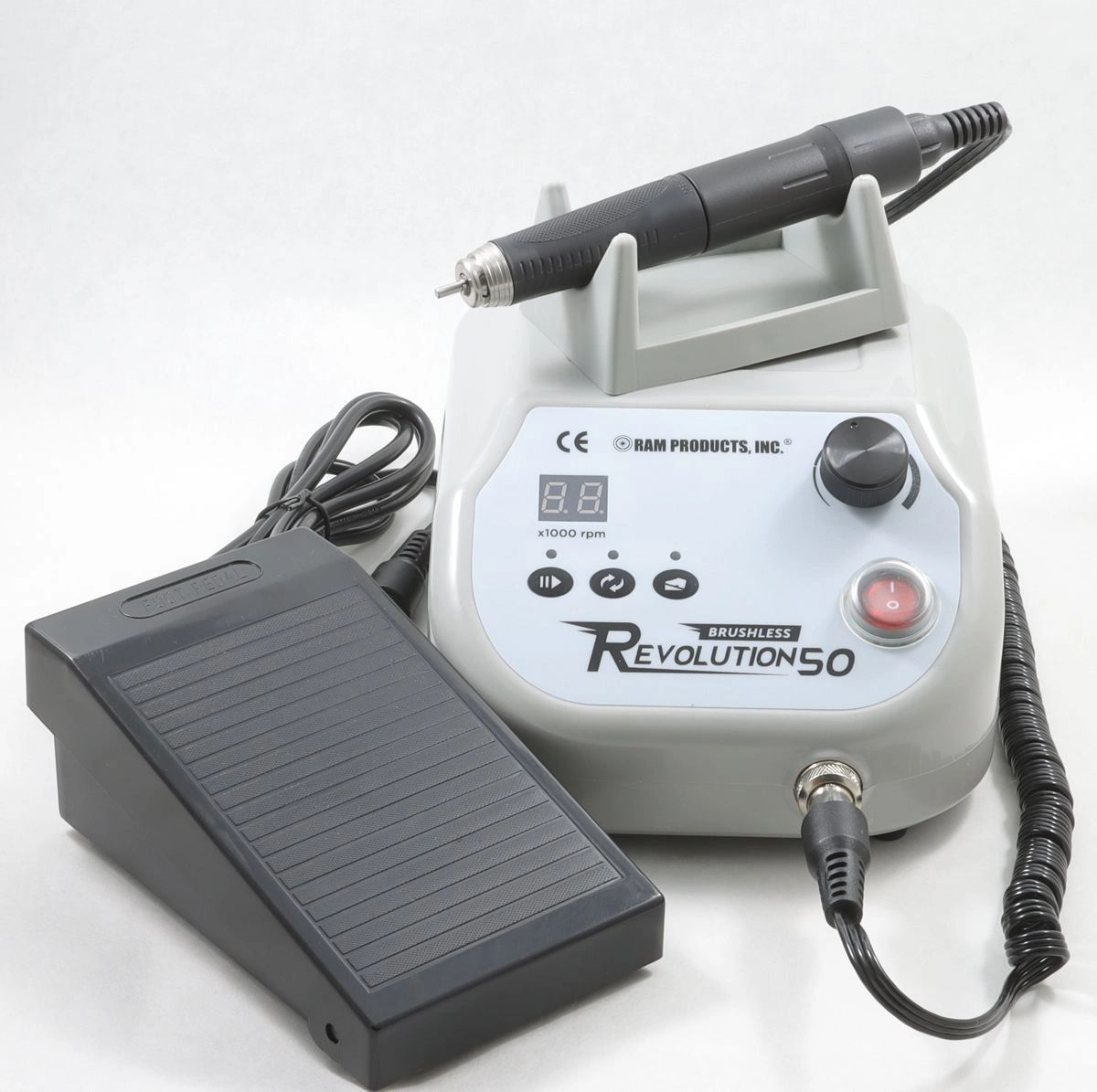
 mdiwoodcarvers.com
mdiwoodcarvers.com
I have been using this for over 2 years and find it adequate for most silversmithing applications, that includes metal shaping, stone setting and deep metal removal for enamelling and other tasks. It has a torque of 7.0 Ncm. Opening diameter of the handset is 1/8" and you can get collet adaptors for the most common burr sizes in jewellery making - 3/32 and 1/16 (FG). It has foot controller, reverse option and speed dial for 1000 to 50 000 rpm that you can set at whatever speed you find appropriate for the material, burr and the kind of work you are doing. Price is very good compared to similar products.
Another one you might want to look at is brushless micromotor, RAM Revolution 50.
I purchased mine from US based woodcarving supply house, link below but you can get it directly from Ram Products etc. I have a feeling it is very similar to Saeshin product.

Ram Revolution 50 Brushless Micro-Motor
07-REV50 Revolution 50 brushless micro-motor unit. REVOLUTION 50 SET INCLUDES: Revolution 50 controller, Revolution 50 handpiece, 1/8" chuck, 1/8" to 3/32" collet adapter, and variable speed pedal Controller Features: Controller Top can be used to hold burs or handpiece holder Precise Digital...
 mdiwoodcarvers.com
mdiwoodcarvers.com
I have been using this for over 2 years and find it adequate for most silversmithing applications, that includes metal shaping, stone setting and deep metal removal for enamelling and other tasks. It has a torque of 7.0 Ncm. Opening diameter of the handset is 1/8" and you can get collet adaptors for the most common burr sizes in jewellery making - 3/32 and 1/16 (FG). It has foot controller, reverse option and speed dial for 1000 to 50 000 rpm that you can set at whatever speed you find appropriate for the material, burr and the kind of work you are doing. Price is very good compared to similar products.
Sinterklaas
Elite Cafe Member
The Saeshin OZ black uses a different plug. So it wont work.I'm using this one. do you think if I got the handpiece and foot control my power supply would run it. the motor is in the handpiece so provided this is supplying the right kind of volts and amps perhaps I could save some money
View attachment 53360
The Osaka Page doesn't show any power/ torque.
The machine Farmer57 linked looks good on paper. Is hat 7Nm of torque. I think that is the same as the Saeshin OZ Black. For a much more reasonable price. Only thing against it that I can see is that it need an adaptor to fit standard burrs. I dont like that.
I also watched your video. I would recommend to have hold the handpiece like a pencil. So rest the motor on the part between your thumb and index finger. You are holding it to lightly.
Have it rest on the web part of your hand. And with your fingers grip the handpiece as low and near to the burr as possible. A good grip is essential.
Honestly I think it is your grip. And I hope it is. Because that is a cheap fix.
Also with a loupe or microscope check if all the cutting flutes of the burr are still intact. If even 1 is chipped may tend to run off.
See in the picture how I hold handpiece. The pinky and ringfinger are on the work or against the ballvise.
The other fingers are gripping the nose of the handpiece. And my index finger is sometimes on the shaft of the burr. But your handpiece is a bit bigger so you probably cant do that. But grip as low as possible.
The weight of the motor is in your video in the air. While in my photo it is resting, it cant move. And neither can the burr.
Attachments
Last edited:
farmer57
Member
Yes, I believe that is 7.0 in torque.
Adapters are just sliding in and out, no tools to change them. For my work it is great as I switch between burrs of FG (1/16") and 1/8" very often. The MDI Woodcarving site included both adapters so there was no added cost.
I've had no issues when working in gold, silver, copper, brass, bronze or steel with the tool and I put it through good 'workout' almost every day. It is very quiet too. The foot control is variable - so you can control your speed and when fully pressed it will ramp up to whatever maximum rpm you set by the rotary dial but not past it.
Adapters are just sliding in and out, no tools to change them. For my work it is great as I switch between burrs of FG (1/16") and 1/8" very often. The MDI Woodcarving site included both adapters so there was no added cost.
I've had no issues when working in gold, silver, copper, brass, bronze or steel with the tool and I put it through good 'workout' almost every day. It is very quiet too. The foot control is variable - so you can control your speed and when fully pressed it will ramp up to whatever maximum rpm you set by the rotary dial but not past it.
Sinterklaas
Elite Cafe Member
Ah ha I see. I thought the adapters where sticking out. Since those exist too.Yes, I believe that is 7.0 in torque.
Adapters are just sliding in and out, no tools to change them. For my work it is great as I switch between burrs of FG (1/16") and 1/8" very often. The MDI Woodcarving site included both adapters so there was no added cost.
I've had no issues when working in gold, silver, copper, brass, bronze or steel with the tool and I put it through good 'workout' almost every day. It is very quiet too. The foot control is variable - so you can control your speed and when fully pressed it will ramp up to whatever maximum rpm you set by the rotary dial but not past it.
But these collets go in the existing collet to make them smarter. Then I have nothing bad to say. Because if it was sticking out you would get a very long tool sticking out. Making it very wobbly.
But this is a very elegant solution.
farmer57
Member
I

21 October 2024
youtube.com
here is a video of what happens when I introduce a round bur slightly larger than the drill hole. I get chatter. maybe I should replace the brushes. happens with all my round burs. best I can do is gently touch it at a shallow angle but that's not good either.
Dani Girl,
Just looked at your video. You might be a bit aggressive in your approach, just as Sinterklaas mentioned - slower does it and with lighter touch but hold the tool steady. Also (in case if you don't) use burLife (or similar) very often, especially with 'grabby' softer metals. Also, try diamond burs with your existing setup - there are different grits and are a bit less 'chattery', especially if used in progression. As a last suggestion, perhaps you might have too aggressive cut on your bur. Generally, more or finer teeth/cuts - smoother but slower cutting. Some are better with softer metals but not as good on harder and vice-versa.
I can't get it to quote the shipping for the ram.
ebay seller says they have one of these left for Aussie 240v. https://www.ebay.com.au/itm/1738509...QGKAtyFRTW&var=&widget_ver=artemis&media=COPY
this one is really tempting. I watched a YouTube the other day where she raved on about the torque this unit has at very low revs.
I can get foredom on ebay for as cheap as the saeshin black. I'm not knocking those units... had a saeshin for years. loved it. upgraded to this marathon that had higher rpm and did better trophy and jewellery and all sorts of engraving with it.
ebay seller says they have one of these left for Aussie 240v. https://www.ebay.com.au/itm/1738509...QGKAtyFRTW&var=&widget_ver=artemis&media=COPY
this one is really tempting. I watched a YouTube the other day where she raved on about the torque this unit has at very low revs.
I can get foredom on ebay for as cheap as the saeshin black. I'm not knocking those units... had a saeshin for years. loved it. upgraded to this marathon that had higher rpm and did better trophy and jewellery and all sorts of engraving with it.
https://www.ebay.com.au/itm/1865345...QGKAtyFRTW&var=&widget_ver=artemis&media=COPY. the seller says this one will work in 240v. $666
and the foredom 1040 seller said he has one for 240v. over $1000.
and the foredom 1040 seller said he has one for 240v. over $1000.
has anyone used a foredom 1040?


